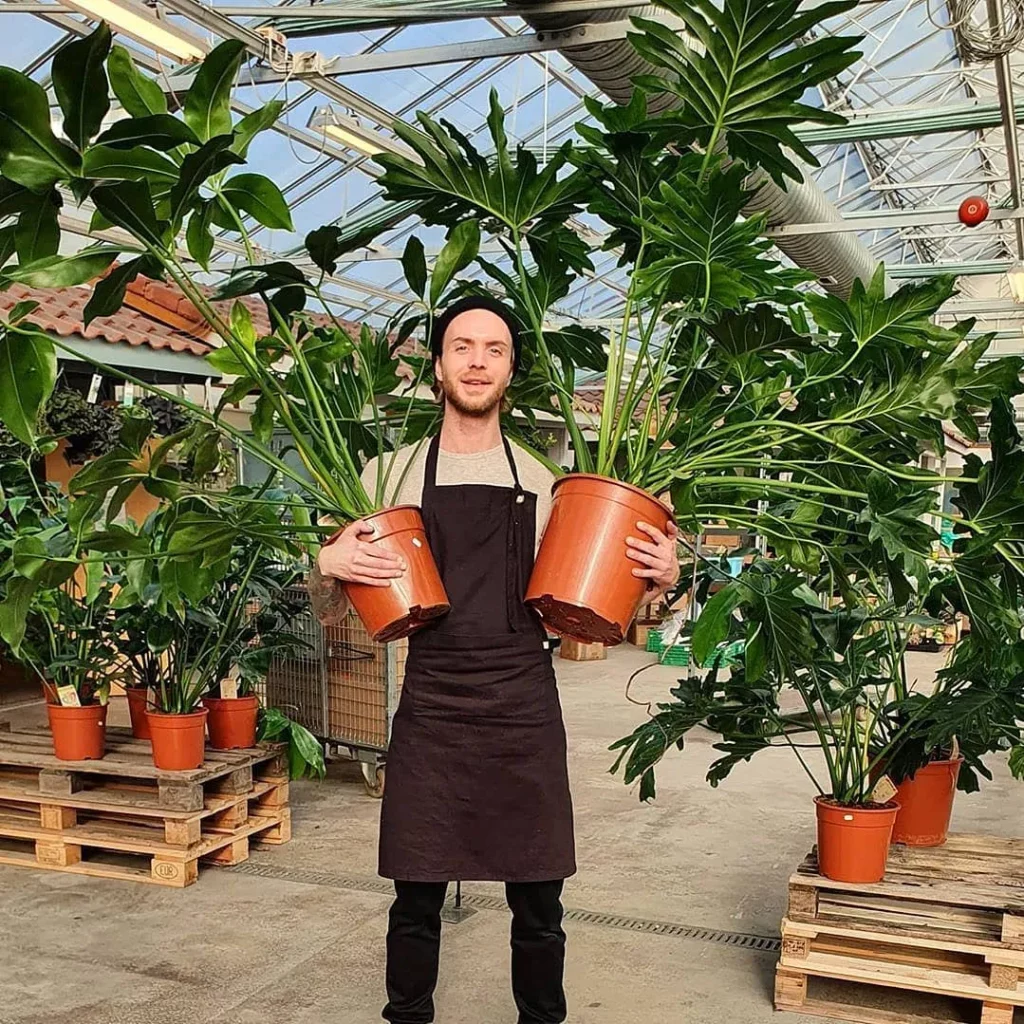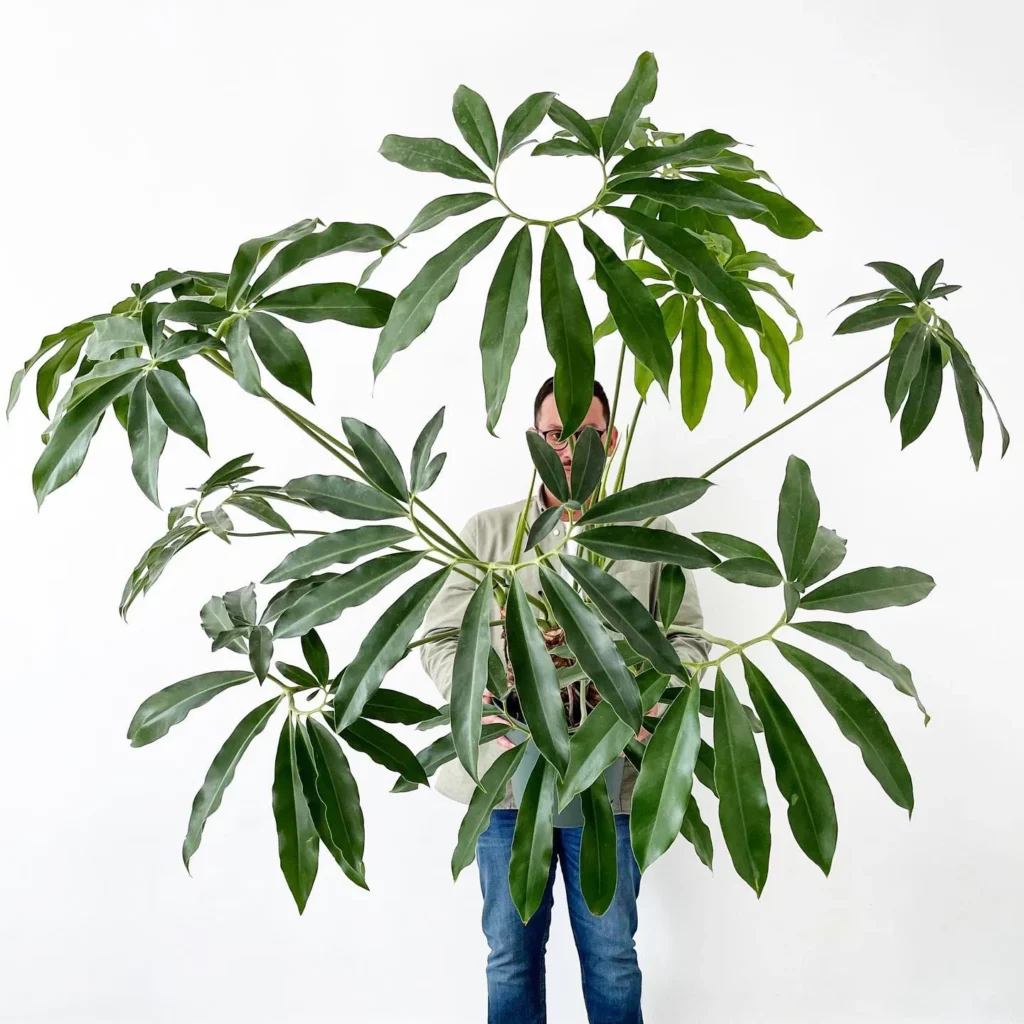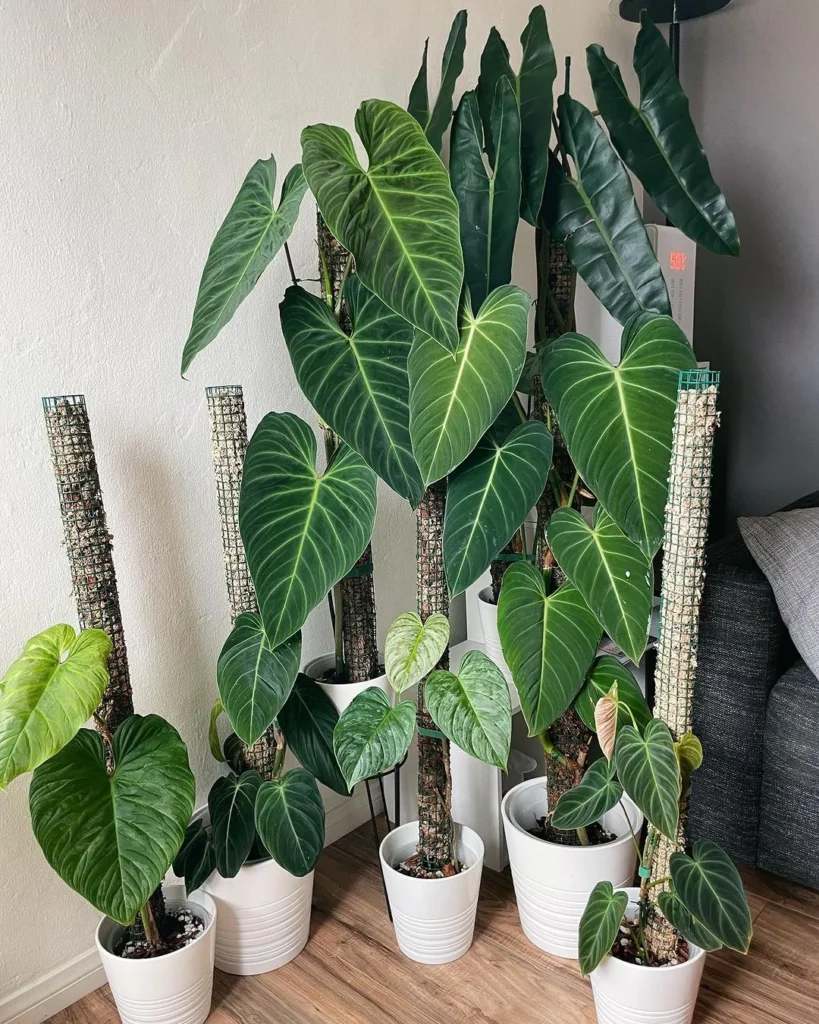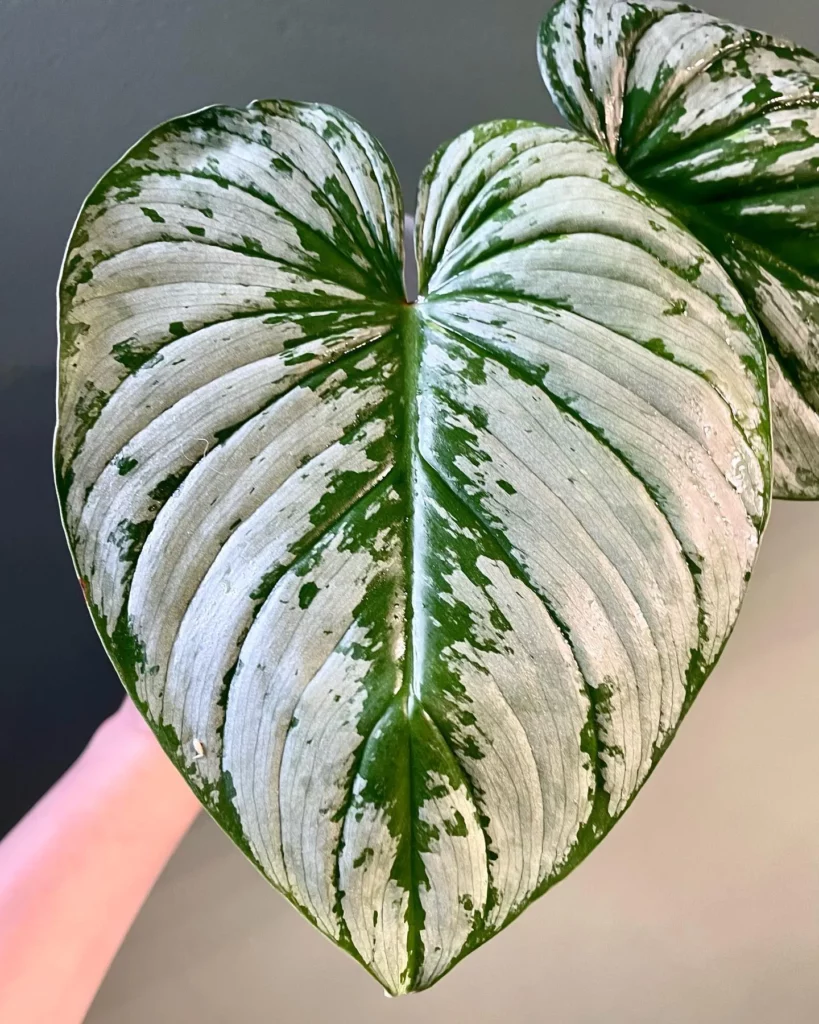Welcome to my guide on growing and caring for Philodendron Goeldii, also known as Thaumatophyllum spruceanum. This tropical plant is known for its lush green foliage and compact form, making it a beautiful addition to any indoor or outdoor space.
Key Takeaways:
- Philodendron Goeldii requires moderate sunlight, moist and well-drained soil, above-average humidity, and temperatures between 50-86 degrees Fahrenheit.
- It thrives in a slightly acidic to slightly alkaline soil with a pH range of 5-8.
- Philodendron Goeldii prefers bright indirect sunlight and a humidity level of 60%-80%.
Appearance of Philodendron Goeldii



When it comes to the appearance of Philodendron Goeldii, prepare to be captivated by its unique foliage. This tropical plant showcases eye-catching, spiral-shaped leaves that add a touch of elegance to any space. The lush green foliage consists of long finger-shaped leaves that grow in a compact, umbrella-style arrangement on horizontal stems. With a height of up to 8 inches and a width of 4 inches, this plant creates a visually striking display that is bound to be the center of attention in your indoor or outdoor garden.
The dark green color of the leaves adds depth and richness to the overall look of the plant. Each leaf is beautifully shaped, with a graceful curve that creates a sense of movement. Philodendron Goeldii truly stands out among other tropical plants, thanks to its fascinating growth pattern and distinct leaf shape.
Foliage:
- Spiral-shaped leaves
- Long finger-shaped leaves
- Compact, umbrella-style arrangement
- Dark green color
Leaf Size:
- Height: Up to 12 inches
- Width: 6 inches
No products found.
Light Requirements for Philodendron Goeldii



When it comes to growing Philodendron Goeldii, understanding its light requirements is essential for its overall health and development. This tropical plant thrives in bright indirect sunlight, making it ideal for indoor spaces. It prefers medium to low light conditions and should be placed near a north-facing window or in an area with filtered or dappled light. Direct sunlight can cause the leaves to dry out and become damaged.
It’s important to keep in mind that Philodendron Goeldii is sensitive to cold temperatures. During the winter months, if the plant is grown outdoors, it should be brought inside to protect it from freezing temperatures. This will help ensure that the plant remains healthy and continues to thrive.
Proper Lighting Tips for Philodendron Goeldii:
- Place the plant in a location with bright indirect sunlight.
- Avoid direct sunlight, as it can cause leaf burn and damage.
- Consider placing the plant near a north-facing window or in an area with filtered or dappled light.
- During winter, bring the plant indoors to protect it from cold temperatures.
Watering Philodendron Goeldii



Proper watering is essential for the health and well-being of Philodendron Goeldii. To maintain optimal moisture levels, it’s important to follow a watering routine that suits the plant’s needs. Here are some tips on how to water your Philodendron Goeldii:
- Watering Frequency: Philodendron Goeldii prefers to have its soil moist but not waterlogged. A good rule of thumb is to water the plant twice a week, allowing the soil to dry out between waterings. This prevents overwatering, which can lead to root rot.
- Watering Amount: During the plant’s growing stage, water the soil until it is fully saturated, and moisture becomes visible on the surface. This ensures that the roots receive enough hydration to support healthy growth.
- Winter Care: In winter, when the plant’s growth slows down, reduce the frequency of watering. Allow the soil to dry out a bit more between waterings to prevent waterlogging.
Fertilizing Philodendron Goeldii



Fertilizing Philodendron Goeldii is an important aspect of its care routine. By providing the right nutrients, you can ensure healthy growth and vibrant foliage. Here are some key points to remember:
Fertilizer selection:
Choose a medium-balanced fertilizer with a ratio of 10:10:10 (nitrogen, phosphorus, potassium). This balanced blend will provide essential nutrients for the plant’s overall health and development.
Fertilizing frequency:
Fertilize Philodendron Goeldii once a month during the growing season, especially in spring and summer. This will help support its rapid growth and encourage lush green foliage.
Winter fertilization:
During winter, it’s best to stop fertilizing your Philodendron Goeldii. The plant enters a period of dormancy, and it requires less nutrients during this time. Resume fertilization in spring when the plant begins its active growth again.
Application method:
Apply the fertilizer according to the manufacturer’s instructions. Typically, you’ll need to dilute the fertilizer in water and apply it to the soil around the base of the plant. Avoid direct contact with the foliage, as this can cause leaf burn.
Potting Philodendron Goeldii



Potting Philodendron Goeldii is a crucial step in its care routine that ensures healthy growth and development. Here are some essential guidelines to follow when repotting your Philodendron Goeldii:
1. Timing:
It is recommended to repot Philodendron Goeldii every two years or when the roots have outgrown the current pot. Spring or early summer is the ideal time to repot, as the plant is actively growing and can recover quickly.
2. Pot Selection:
Choose a new pot that is 2-3 inches larger in diameter than the current pot. Clay or terracotta pots are preferred as they provide better moisture absorption. However, if you tend to forget watering regularly, plastic pots can also work well.
3. Soil:
Use a well-drained potting mix that allows excess water to drain away easily. A mix of peat moss, perlite, and sand provides a suitable medium for Philodendron Goeldii. Avoid compacting the soil too tightly, as it can hinder proper drainage.
4. Repotting Process:
- Gently remove the plant from its current pot, being careful not to damage the roots.
- Inspect the roots for any signs of rot or disease. Trim away any damaged or rotting roots with sterile pruning shears.
- Place a layer of fresh potting mix at the bottom of the new pot.
- Position the Philodendron Goeldii in the center of the pot and fill the remaining space with the potting mix, gently pressing it down to secure the plant.
- Water the plant thoroughly to settle the soil and encourage healthy root growth.
Propagating Philodendron Goeldii



Propagating Philodendron Goeldii is an exciting way to expand your collection or share the joy of this beautiful plant with others. There are several methods you can use to propagate Philodendron Goeldii, including stem cuttings and layering techniques.
Stem Cuttings
- To propagate Philodendron Goeldii using stem cuttings, select a healthy, mature stem with at least two nodes.
- Using a clean, sharp knife or pruning shears, make a clean cut just below a node.
- Remove any lower leaves, leaving only a few leaves at the top.
- Dip the cut end in rooting hormone, if desired, to encourage root growth.
- Place the cutting in a well-draining potting mixture, ensuring that at least one node is below the soil surface.
- Keep the cutting in a warm, humid environment with bright, indirect light.
- Mist the cutting regularly to maintain moisture and promote root development.
- After a few weeks, you should start to see roots forming, indicating successful propagation.
Layering Methods
Layering is another effective way to propagate Philodendron Goeldii. This method involves burying or pinning part of the plant to the ground or covering it with soil to encourage root growth. There are various layering techniques you can try, including tip layering, compound layering, stooling layering, and French layering.
Each technique involves a different approach but follows the same principle of promoting root development while the cutting is still attached to the parent plant. Layering can be a slower process compared to stem cuttings, but it can yield a higher success rate.
Growth and Development of Philodendron Goeldii



Philodendron Goeldii is a tropical plant with a fast growth rate, particularly during the spring and summer seasons.
This plant develops long, clustered leaves that resemble fingers, creating a visually stunning display. However, it’s important to note that Philodendron Goeldii is intolerant to excessive direct sunlight and cold winters. Excessive sunlight can lead to leaf burn, while cold temperatures can cause wilting and leaf drop.
Proper care is essential to ensure the healthy growth and development of Philodendron Goeldii. Providing bright indirect sunlight is crucial, as it promotes optimal growth without the risk of leaf damage. Maintaining a moderate temperature between 50-86 degrees Fahrenheit helps the plant thrive. Philodendron Goeldii also benefits from a humid environment with a humidity level ranging from 60%-80%. This can be achieved by misting the leaves regularly or placing a humidifier nearby.
Regular watering is necessary to keep the soil moist but not waterlogged. Philodendron Goeldii should be watered twice a week, allowing the soil to dry out between waterings to prevent root rot. During the growing season, the soil should be thoroughly saturated, with moisture visible on the surface.
Key Points:
- Philodendron Goeldii has a fast growth rate, reaching up to 8 inches tall and 4 inches wide.
- It develops long, clustered leaves in a visually striking pattern.
- Excessive sunlight can cause leaf burn, and cold temperatures can lead to wilting and leaf drop.
Pests and Diseases of Philodendron Goeldii



Philodendron Goeldii is generally a resilient plant, but it can still be susceptible to certain pests and diseases. It’s important to keep an eye out for any signs of trouble to ensure the health and vitality of your plant.
Pests
Common pests that may affect Philodendron Goeldii include:
- Fungus Gnats: These small flying insects are attracted to the moist soil of the plant. To prevent fungus gnats, allow the soil to dry out between waterings and avoid overwatering.
- Aphids: These tiny insects can cluster on the leaves and stems of the plant, sucking the sap and causing damage. They can be removed by gently washing the leaves with a diluted dish soap solution or by using organic insecticidal sprays.
- Spider Mites: These microscopic pests can cause webbing on the leaves and lead to discoloration and leaf drop. Regularly misting the leaves and keeping the humidity levels high can help prevent spider mite infestations.
Diseases
Common diseases that may affect Philodendron Goeldii include:
- Root Rot: Overwatering or poor drainage can lead to root rot, which is caused by fungus and can result in the wilting and yellowing of leaves. To prevent root rot, ensure that the soil is well-drained and avoid overwatering.
- Leaf Spot: This fungal infection can cause brown or black spots on the leaves, leading to their eventual death. Remove infected leaves and ensure good air circulation around the plant to prevent the spread of leaf spot.
About Philodendron Goeldii



Philodendron Goeldii, also known as Thaumatophyllum spruceanum, is a tropical plant native to French Guiana. With its striking spiral-shaped leaves and compact growth habit, it adds a touch of elegance to any indoor or outdoor space. This beautiful plant features lush green foliage and blooms throughout the year, creating a vibrant display.
With its easy-care requirements, Philodendron Goeldii is suitable for both experienced plant enthusiasts and beginners.
Known for its resilience, Philodendron Goeldii can adapt to different light conditions and environmental factors. However, it thrives best when provided with bright indirect sunlight, moist and well-drained soil, and a humidity level of 60%-80%. By following these care guidelines, you can enjoy the beauty of Philodendron Goeldii and create a vibrant and thriving green space.
FAQ
What is the appearance of Philodendron Goeldii?
Philodendron Goeldii has lush green foliage with long finger-shaped leaves that grow in a spiral arrangement. It can grow up to 8 inches tall and 4 inches wide, creating a visually striking display.
What are the light requirements for Philodendron Goeldii?
Philodendron Goeldii prefers bright indirect sunlight. It should be placed near a north-facing window or in an area with filtered or dappled light. Direct sunlight can cause leaf damage.
How should I water Philodendron Goeldii?
Philodendron Goeldii likes to have its soil moist but not waterlogged. It should be watered twice a week, allowing the soil to dry out between waterings. Overwatering can lead to root rot, so it’s important to avoid excessive watering.
How often should I fertilize Philodendron Goeldii?
Philodendron Goeldii benefits from regular fertilization during the growing season. A balanced fertilizer with a ratio of 10:10:10 should be applied once a month. In winter, it’s best to stop fertilizing the plant.
How should I pot Philodendron Goeldii?
Philodendron Goeldii prefers to be root-bound and doesn’t like to be moved often. Repotting should be done every two years or when the roots have outgrown the pot. The new pot should be approximately 2-3 inches larger than the previous pot, and the soil should be well-drained.
How can I propagate Philodendron Goeldii?
Philodendron Goeldii can be propagated through stem cuttings or various layering methods. Stem cuttings should be planted in a potting mixture and kept in dappled sunlight. Layering methods involve burying or pinning part of the plant to the ground or covering it with soil to promote root growth.
How does Philodendron Goeldii grow and develop?
Philodendron Goeldii has a fast growth rate, especially during the spring and summer months. It can grow up to 8 inches tall and 4 inches wide. The plant develops long, clustered leaves that resemble fingers, creating a visually stunning display.
What pests and diseases can affect Philodendron Goeldii?
Philodendron Goeldii can be prone to leaf drop and is susceptible to pests like fungus gnats. Root rot can also occur if the plant is overwatered. Regular inspection of the plant is recommended to catch any issues early and treat them accordingly.
What should I know about Philodendron Goeldii?
Philodendron Goeldii, also known as Thaumatophyllum spruceanum, is a tropical plant native to French Guiana. It blooms throughout the year and is a popular choice among plant enthusiasts. With proper care, it can be a beautiful addition to any indoor or outdoor space.




